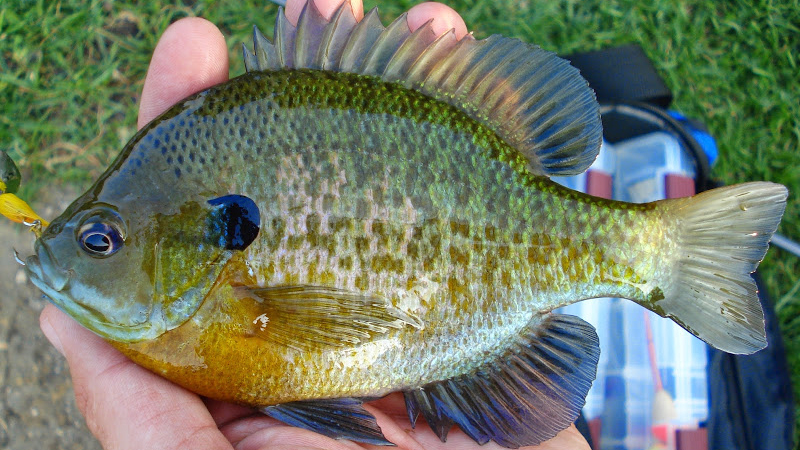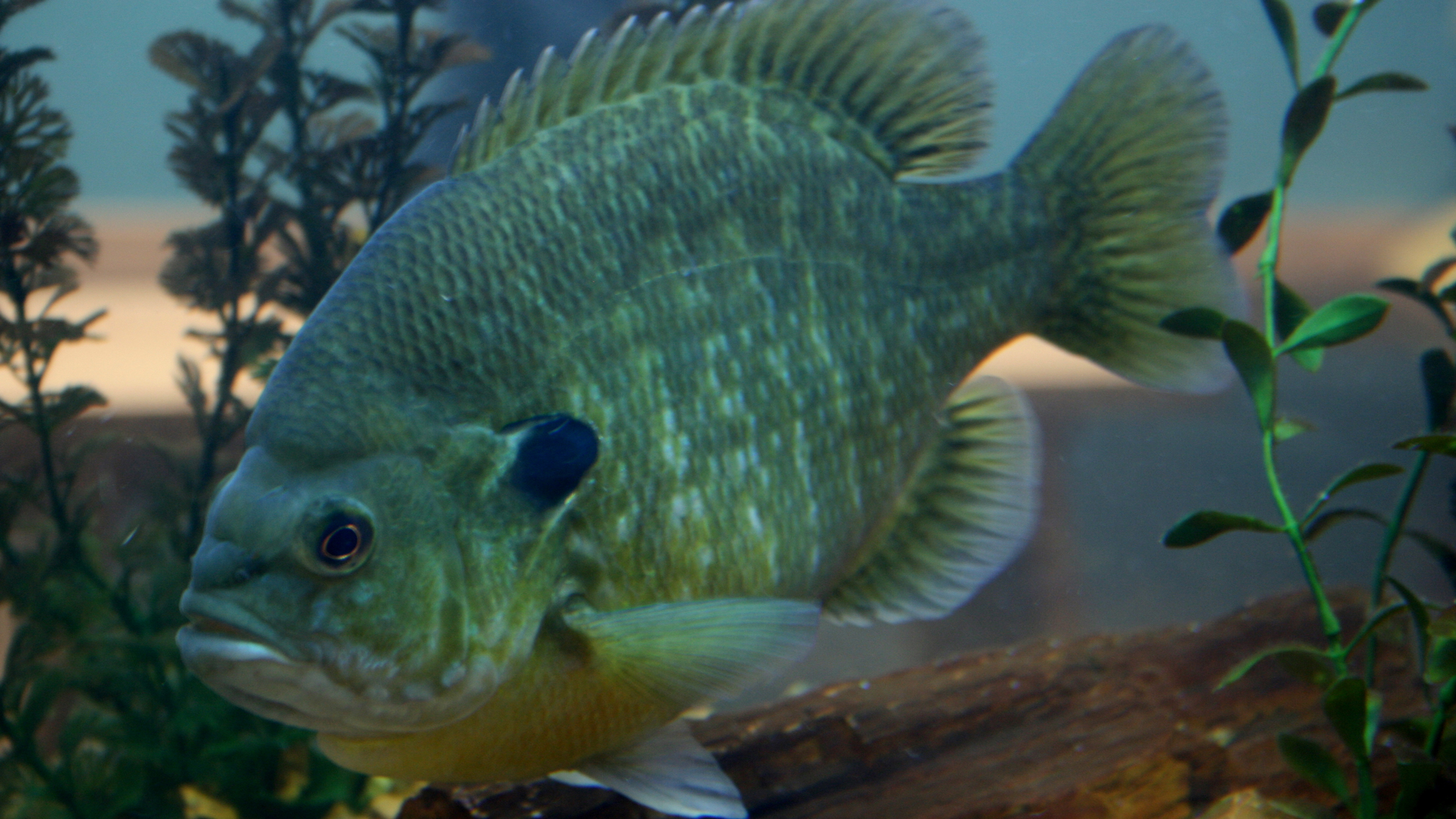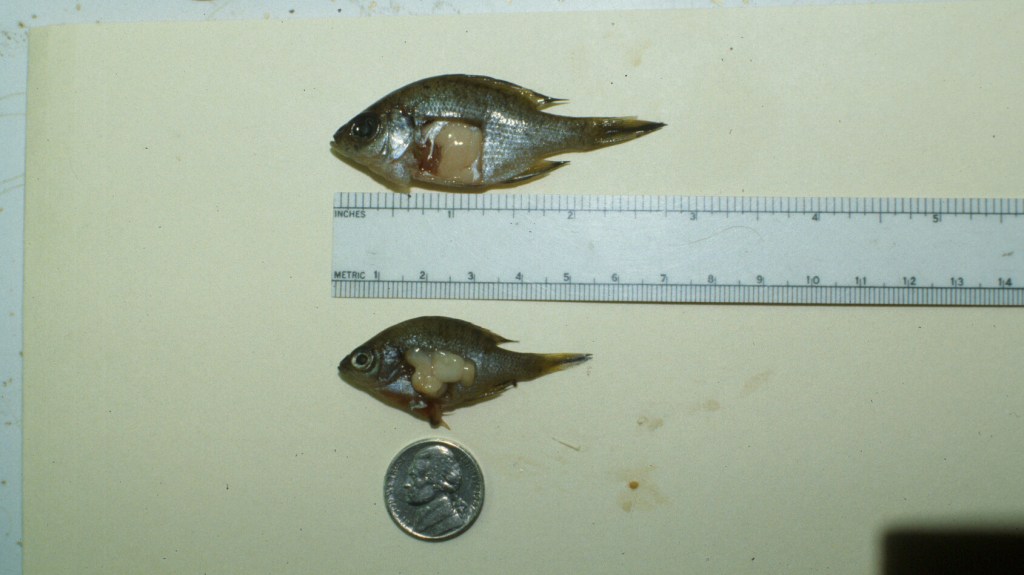The bluegill is easy to take for granted: ubiquitous, easy to catch, quite likely swimming in a water body near you.
But, come spawning season, a bluegill colony may be one of the wilder scenes in nature: part barroom brawl, part cheesy ‘80s romantic comedy.
And this rowdy scene could actually have conservation implications.
The Biggest, Baddest Bluegill
Come spring, bluegills set up spawning beds – where the eggs are laid and protected. Central to spawning is what biologists call the parental male: a big bluegill that not only competes to reproduce with females, but also protects the eggs laid on the spawning bed.
Parental males clear the spawning beds of debris and guard them.
The bigger and badder the male, the better the location of the spawning bed. At the center of the colony, in the best position to fend off predators and other males, is the biggest and baddest bluegill of all.
“These males put all their energy into defending the nest and competing with the other male bluegills for the best females,” says Andrew Rypel, a research biologist with the Wisconsin Department of Natural Resources and bluegill expert. “All their energy goes into body growth. Being a parental male is a tough business, but his first goal is to attract a fantastic female mate. The female leaves after laying eggs, and the male has to guard the nest.” So far, this does not sound too outlandish: big males battle it out for the best females. The most fit and aggressive individuals are most attractive. The strongest pass on their genes. It’s a pretty standard wildlife narrative, right?
But here’s the wild card: Not all males participate in the festivities. As the jocks of the bluegill realm wage their battles, puny little specimens are watching on the sidelines. Biding their time.
The Little Fish with Very Big Gonads
“Bluegill males can have two completely different life histories,” says Rypel. “Some males opt out completely from growing big and guarding spawning beds. They become what we call sneaker males.”
Sneaker males are small. They do not look like they could win any battle. To an untrained eye, they may look like a different species.
Whereas the parental male puts all his energy into a big, strong body, the sneaker male puts all the energy into giant gonads.

“The sneaker male has stunted growth, but his testes are blown up like balloons,” says Rypel. “Whatever energy he acquires goes right into the testes.”
While the parental males are battling and protecting the spawning bed, the sneaker malesare roving around. And when the parental males are courting females, or fighting, the sneaker males, true to their name, sneak right onto the spawning bed.
“Because they have these huge testes, they have a lot of sperm,” says Rypel.
And so the sneaker male passes on his genes, too. It’s like that film where the quiet, wimpy guy wins out over the preening jock.
But there’s one more complication to the spring spawning bash – anglers.
The Big Fish That Didn’t Get Away
Bluegills are a favorite of anglers, especially in the spring, when they’re on the spawning beds. They’re easy to see, and easy to catch.
“Anglers aren’t interested in the sneaker males because they’re small,” says Rypel. “They’re targeting the biggest and most visible fish. And that means parental males.”

The parental males thus get hammered, leaving behind the small fish to do the breeding.
In many states, bluegill harvest limits are liberal. In Wisconsin, where Rypel works, the limit is 25 per day. What impact does removing all these parental males have on the population?
Many anglers think they know the answer: Not much. A common bit of fishing wisdom is that bluegills are prone to overpopulation, and harvesting as many as possible is necessary to prevent stunting.
But perhaps this ignores the complexity of bluegill social hierarchy.
And now new research conducted by Rypel casts doubt on that conventional wisdom. Heavy angling pressure may not reduce stunting at all. In fact, it may lead to decreases in fish size – the subject of tomorrow’s blog.




Thankyou for this science based information . Not everything is as it first appears. The world is not flat the sun doesn’t circle the earth and the moon is not bigger than the stars
I have not taken any BG from my pond in 10 years and they are still small in size. The bigest BG I have got is 4.5″
Why not put some of the spawning beds off limits to fishing?
I’m from michigan and I have seen this in action (stunting) .I have fished Indian lake in Kalamazoo county since age 10.I have witnessed the frequency of the stunted males grow exponentially over the past 15 years. Most blue gill anglers on our lake fish the beds heavily for the first two weeks while the fish are actively breeding. I’ve trolled around the beds to see the results for myself. Most years every single fish in bed complexes are taken leaving the small fish to breed. The average fish we avid anglers have been catching is shrinking. It used to be nothing to catch a mess averaging 7 inches with several fish being 8 inches or bigger in that mess. Lately the fish right inches or bigger have become the rarity rather than the commonplace. Not only that but the shape of the fish seems to be changing as well . It used to be that the fish were long with very stout bodies and exaggerated bumps on their heads most fish ten inches or longer looked like the back meat was trying to roll over their heads. Now more frequently, fish the same height belly to back as the eight and ten inch fish are about a quarter the length of the classically shaped fish I am used to. We call them football’s because of their funny exaggerated short bodies. These fish produce less meat than the classically shaped blue gills and I keep them now not so much to eat as to get everyone I come across out of the gene pool. I have also imposed an eight inch keeper limit on myself and encouraged others to do the same.
Matt, I write our club newsletter and would like to include this article for a read for our membership. If possible, could you send the article to hlamey@att.net, I would appreciate it and I’m sure our membership would well receive it also. We are located in south Mississippi right on the Gulf Coast. Our club does a little saltwater fishing but our main focus is on bull bluegill. We are a fly fishing club. Our fly fishing club site is gcflyfishers.org should you want to take a gander at the site, be sure to check out the facebook page tab on the home page. Thank you, Harry A. Lamey
Good stuff! Keep it coming!
Size limits and quantity limits are in order.
great fish
Cool “blue” science indeed. I had no clue about these sneaky sneakers 🙂